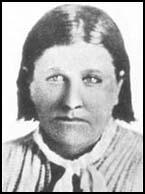Cynthia Ann Parker

Cynthia Ann Parker was born in Crawford County, Illinois, in around 1827. When Cynthia was a child the family moved to Texas. Her uncle, Daniel Parker, was head of the Texas branch of the Primitive Baptist Church and the family were involved in missionary work.
To protect themselves from hostile Native Americans the Parker family built substantial walls around the community and the settlement became known as Fort Parker.
In 1836 Fort Parker was attacked by a Comanche war party. Five members of the settlement were captured, including nine year old Cynthia. Over the next few years all the captives, except for Cynthia, were allowed to return to home. Cynthia was adopted by a Comanche couple who raised her like their own daughter. Attempts were made by Cynthia's family to buy her freedom. However, Cynthia was devoted to her new parents and after appealing to the tribal council was allowed to stay.
Cynthia eventually married the young chief Peta Nocona. The couple had three children, Quanah, Pecos and Topsannah. Peta Nocoma and his warriors carried out several raids on local white settlements and in December, 1860, Lawrence Sullivan Ross and a party of Texas Rangers were sent out to find Peta Nocoma. They found his camp on the banks of the Pease River. Peta Nocoma and his two sons, Quanah and Pecos, were out hunting, but most of the camp, including sixteen women, were killed. Cynthia was spared because of her blue eyes and European features.
Cynthia and her daughter Topsannah were taken to Camp Cooper where she was identified by Isaac Parker as being the girl who had been kidnapped 24 years ago. Cynthia pleaded to be allowed to return to her Comanche family. This idea was rejected and Cynthia and Topsannah were taken to live in Parker's home at Birdsville.
The Texas legislature voted her a pension of $100 a year as compensation for being kidnapped by the Comanches. Parker did what he could to persuade Cynthia to adopt American ways. This strategy was unsuccessful and eventually she had to be locked up to stop her from returning to Peta Nocoma and her two sons.
In 1863 Cynthia received word that Peta Nocona had been killed and her son Pecos had died of smallpox. Soon afterwards her daughter, Topsannah, died of pneumonia. Cynthia now became desperate to be reunited with Quanah. The Parker family refused and eventually Cynthia resorted to going on hunger strike. Cynthia Ann Parker starved herself to death in 1870.
By this time Quanah had become a chief of the Comanche tribe. He was also desperate to find out what had happened to his mother. In 1875 Quanah surrendered at Fort Sill and was told that his mother had died five years earlier. When Quanah died in 1911 he was buried next to his mother and sister.
